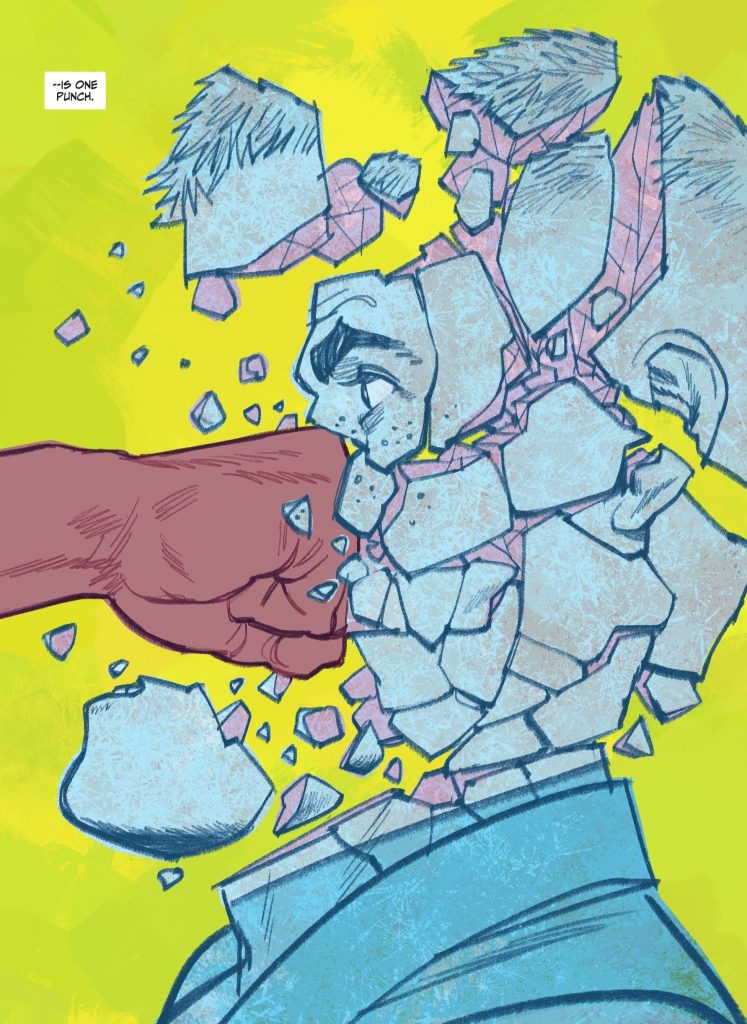In a recent issue of Human Target, Tom King killed off Guy Gardner, prompting many fans to ask if the shocking death was actually in-continuity. (Up to that point, nothing in the arc would have even been questionable as to its continuity status.) King’s response was intriguing. Rather than address the death directly, King took to his Substack blog to write an interesting post about continuity in regard to DC’s Black Label line in general.
Introduced as a replacement for the defunct Vertigo line a few years ago, Black Label’s intention was to exist as a mature/Rated-R (or sometimes NC-17) version of Vertigo or Legends of the Dark Knight, which would feature a mix of in-continuity or out-of-continuity works. Of course, DC never put forth any hard concrete rules about any of this, and King, in his blog post, confirmed that DC still doesn’t have any hard concrete rules when it comes to Black Label continuity (no kidding), emphasizing that his blog entry analysis is his own interpretation of things. According to King, there are three types of Black Label titles.
The first type of Black Label consists of strictly out-of-continuity titles. While King doesn’t actually give any Black Label examples, he does use Vertigo examples—late Sandman, his own Sheriff of Babylon, the majority of Preacher, and The Invisibles. (To be clear, some of these titles have been re-released under the Black Label banner.) These types of stories do not take place in the primary DCU and are thus non-canon.
The second type of Black Label consists of “what if/what might be” books—basically alternate world, possible future, or Elseworld style stories. The Black Label example King uses here is The Dark Knight Returns (and presumably its sequels). King says that these stories, especially possible future stories, are a toss up as to whether or not they become definitive or not. He specifically says that all of the Batman/Catwoman future stuff falls into this category! (He does not elaborate whether he is solely talking about the future bits of the Batman/Catwoman Black Label series, all of which is said to be non-canon, or if he is also talking about the future stuff from his very-much-canon Batman run. However, this does make it clear that King believes that parts of stories can be canon while other parts of the very same story might not be.)
The third type of Black Label consists of titles that “are in the present, abide by all the rules of current continuity, feature big game changing moments, and try to define the characters for the current generation. […] They don’t immediately impact any of the other books on the stand, but can impact the books in the long term. They are not written in continuity, but they can become continuity.” Essentially, Kind is saying that this type is on the canonical fence until referenced by other creators. King’s examples here are The Killing Joke and his titles—Mister Miracle, Strange Adventures, Rorschach, Human Target, and “at least two-thirds of” Batman/Catwoman (presumably the parts that are not in the future, since he placed that third in category #2). It’s pretty messy to write an arc (King’s Batman/Catwoman arc) that falls into multiple brackets of this already vague method of categorization on top of the fact that, as a collected arc/narrative, it starts fully canon. So in this regard, King’s entire Batman/Catwoman arc falls into the categories of canon, “what if/possible future,” and borderline canon (waiting for more references). And by King’s definitions above, there can be overlap between each Black Label type. One story or arc (or even parts of one story or arc) can fall into multiple categories. I think this is a fair grasp of the Barthes-ian concept of canon in general, and it speaks to how reader and creator interpretation dictates canon more than anything else. However, it’s a bit mind-boggling that King, as the person who has more power to dictate canon than anyone else (being the creator himself), has chosen to write stories this way, almost neutering himself in regard to the power he wields. I can’t tell if it is on purpose or not.
Making matters even more confusing is that fact that King has admitted (in the John Siuntres Word Ballon podcast a few years ago) he doesn’t work well with others when it comes to continuity. This was evident with his long Batman run, and it remains evident today. For example, King wrote Dick debuting as Robin early in Year One, prior to Catwoman’s debut. Now, King is writing the ongoing Batman: Killing Time, which is rumored to retcon Robin’s debut a bit later (but still prior to “War of Jokes and Riddles,” also by King, which curiously does not feature or mention Robin). Add conspicuous and possibly contradictory takes on Dick Grayson’s early days/debut as Robin by Tom Taylor (in Nightwing), Jeff Lemire (in Robin and Batman), and Joshua Williamson (in Batman), and we’ve got ourselves a sticky wicket. If we look at King’s comments about the future of his Batman/Catwoman run, trouble brews as well. If that future, which shows an elderly Bruce succumbing to cancer, is possibly not canon, then does that mean that the new (ongoing) Batman Beyond: Neo Year series, which shows an elderly Bruce being murdered by a rogue AI, is canon instead? Maybe we are truly meant to consider all Black Label material as non-canon until otherwise stated or referenced?
Much of what King says in his post implies the current en vogue method of comic book writing for both himself and many others is a style where the author operates on the fringes of continuity, writing an impression of a character with hope (or possibly indifference) as to whether or not the story will get referenced or gain traction later. In this impressionistic style of writing, a writer can shunt aside worries about making immediate sense or having legitimate connectivity to the rest of the line. This style of long-form serialized writing makes sense if you are thinking about readers only engaging with stories via trade paperbacks and collections, but it doesn’t really jibe with the classic (and still current) way of comic book storytelling—week-to-week floppy issue tales that tell a never-ending realtime narrative. The impressionistic style also makes it incredibly difficult for the dedicated fans that read week-to-week and who try to make timelines (or even just try to make sense of ongoing stories in general), because it forces said fans to patiently adhere to a wait and see kind of response or engagement. Imagine watching a continuity-heavy TV show, but there is only tenuous connectivity between episodes and some of the episodes don’t actually happen, but you aren’t told what’s what. This might work for David Lynch or other experimental content, but it would be a disservice toward fans of most straightforward TV. Same thing can be said when it comes to fan interaction with comic books.
While it’s refreshing and eye-opening to hear a big name writer at DC talk so candidly and openly about continuity, especially some of the more confusing aspects of DC’s continuity in particular, let’s be perfectly clear: The most confusing aspects of DC’s continuity have been and continue to be created completely by the company itself. King’s explanations here are illuminating, not so much in terms of helping us better understand DC’s canon, but more so in helping us understand why it’s as confusing as it is.
________________________________________________________________




I’m not sure Lemire’s Robin and Batman is meant to be in-continuity at all, though I can’t remember where I read that. I’ll do some hunting.
I don’t see any possible way Jeff Lemire’s Robin and Batman can be canon as it has Robin debuting during the Satellite Era Justice League, but I’ve had a few folks fighting for it. It really feels like a Black Label book, except it doesn’t have “mature” content (although not all Black Label books seem to have “mature” content in them—Superman vs Lobo stands out in this regard especially). The more I think about Black Label, the less I understand about the line’s intention. Anyway, let me know what you dig up in regard to Robin and Batman! Thanks.
PS I know you’ve been talking about moving Robin’s debut into Year Two… that very well might happen in the near future. We’ll see.
I’m Really glad you wrote about this, my first thought after reading Tom’s substack blog was what you would think about it.
Thanks, Josh! Tom King just recently contradicted himself within his own narrative. Batman/Catwoman Special #1 has Robin debuting later while Batman/Catwoman #11 has Robin on the boat. On Twitter, site contributor Martin Lel directly asked King:
“Since the Batman/Catwoman Special shows Selina finding out about Robin from Joker in her costume, and that would have to go after The Boat, are we to understand the rebirth version of the boat happened without Robin?”
King’s response: “Not a weird question. Yeah I struggle with this too. In my mind, Batman spent years fighting all the rogues before he met Robin, but I know in that first Catwoman boat appearance in 1941 Robin is there…blame it on Superboy Prime banging on the wall.”
A terribly confused response. As a writer, YOU decide what is canon. YOU get to dictate the narrative. The Superboy Prime reference, whether meant to be tongue-and-cheek, is also a head-shaker.
When asked about the continuity of his books by others, King has also said: “I don’t think of any of my books as being out of continuity. I think of them … like [Marvel’s] “Born Again.” You do not see “Born Again” immediately reflected in Avengers. You don’t see Captain America all sad about the flag in Avengers #250 or whatever it was, the next day. But that had happened, right?”
The more King quotes and interviews I read, the more I believe he is either unable or unwilling to participate in serialized group storytelling or continuity narrative.
I love his take, it just reminds me of the just-brought-back Hypertime. The first stories would be parallel timelines, the second ones divergent timelines and the third ones either convergent or parallel, depending of their incorporation into the main timeline.
Oh, and King seems to still confuse Earth 1 with Prime Earth (aka Earth 0)
Tom King is Bob Haney and all his DC work (save Rorschach and Sheriff of Babylon) happens on Earth-K with some that bleeds into the Prime continuity thanks to Hypertime. I love Earth-K’s brand of tone poem adventures.